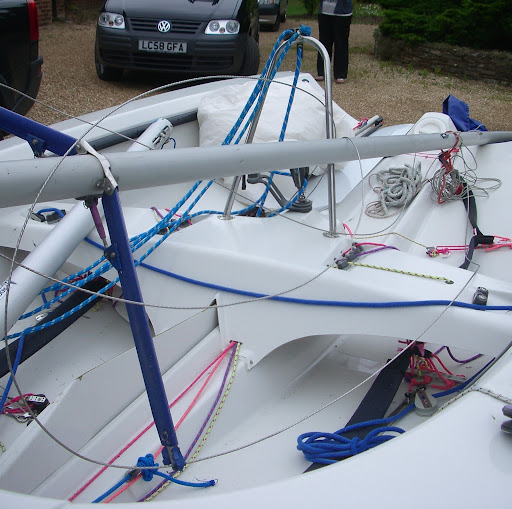Mark J Groves
age ~58
from Meridian, ID
- Also known as:
-
- Ark Groves
- Mark J Grove
- Groves Ark
Mark Groves Phones & Addresses
- Meridian, ID
- Boise, ID
- 117 Riverfront Dr, Cashmere, WA 98815
- 8340 Nahahum Canyon Rd, Cashmere, WA 98815 • (509)7827010
- Monroe, WA
- Chelan, WA
- Seattle, WA
- Lake Stevens, WA
- 2041 S Varian Pl, Boise, ID 83709 • (208)8883842
Work
-
Position:Clerical/White Collar
Education
-
Degree:Associate degree or higher
Specialities
Creditors Rights • Collections • Creditor Bankruptcy • Commercial Litigation • Commercial
Lawyers & Attorneys

Mark Groves - Lawyer
view sourceOffice:
Glasser and Glasser, P.L.C.
Specialties:
Creditors Rights
Collections
Creditor Bankruptcy
Commercial Litigation
Commercial
Collections
Creditor Bankruptcy
Commercial Litigation
Commercial
ISLN:
912376279
Admitted:
1995
University:
Christopher Newport University, B.S., 1987
Law School:
Nova Southeastern University School of Law, J.D., 1995
Name / Title
Company / Classification
Phones & Addresses
Manager
Manray Corp
Drinking Place Eating Place
Drinking Place Eating Place
514 E Pne St, Seattle, WA 98122
(206)5680750
(206)5680750
Manager
Alki Ventures
Full-Service Restaurants
Full-Service Restaurants
514 E Pne St, Seattle, WA 98122
(206)5680750
(206)5680750
PRESTIGE PHOTOGRAPHY, LLC
Us Patents
-
Enable Top-Down Service Design
view source -
US Patent:8086992, Dec 27, 2011
-
Filed:Feb 14, 2007
-
Appl. No.:11/705921
-
Inventors:Bill Gibson - Woodinville WA, US
Mark Groves - Monroe WA, US
Ross Grayum - Monroe WA, US
Vinay Bharadwaj - Seattle WA, US -
Assignee:Microsoft Corporation - Redmond WA
-
International Classification:G06F 9/44
-
US Classification:717100
-
Abstract:Various technologies and techniques are disclosed for providing a software development application that supports development using a top-down approach. The user creates a high-level system design for a system in the top-down design software development application. The user describes a behavior of the system by attaching technology-neutral original system endpoints and respective contracts to a plurality of system components. The user delegates each original system endpoint to a member endpoint of a corresponding technology-specific member component. The user supplies a concrete implementation for each of the corresponding technology-specific member components. Throughout this iterative development process, the high level system design is preserved.
-
Architectural Data Metrics Overlay
view source -
US Patent:8413108, Apr 2, 2013
-
Filed:May 12, 2009
-
Appl. No.:12/464105
-
Inventors:Mark Groves - Monroe WA, US
Daniel Massey - Redmond WA, US
Ian Bavey - Sammamish WA, US
David Sauntry - Redmond WA, US -
Assignee:Microsoft Corporation - Redmond WA
-
International Classification:G06F 9/44
-
US Classification:717104, 717105, 717131
-
Abstract:A system and method for facilitating analysis of a software project. Intrinsic measures, activity-based measures, or dynamic measures associated with the project are received, including measures associated with physical program units and logical program units of the project. Mappings between physical program units and logical program units are generated. An architectural diagram including logical program units is received, and may include additional mappings of the logical program units. The mappings are used to roll up measures from physical project units to logical project units, and from logical project units to other logical project units. An overlay diagram is generated, including the rolled up measures. The overlay diagram includes the architectural diagram and a representation of rolled up measures associated with each logical project unit on the diagram. The representations employ a graphic format that facilitates a user determining risk areas of the software project.
-
Using Web Model Feeds To Version Models Which Are Defined In Modeling Languages
view source -
US Patent:8601440, Dec 3, 2013
-
Filed:Nov 10, 2009
-
Appl. No.:12/615612
-
Inventors:Dan Massey - Redmond WA, US
Mark Groves - Monroe WA, US -
Assignee:Microsoft Corporation - Redmond WA
-
International Classification:G06F 9/44
-
US Classification:717122
-
Abstract:Versions of a model in UML or another modeling language can be published on web feeds, such as RSS or Atom web feeds. A model feed includes a sequence of incremental differences to a base version of a model; the base version can be an empty model or a snapshot of another model feed, for example. Stream charts show the relationship between model feeds. A selected sequence of incremental differences can be applied, in forward or reverse, to animate changes in a model. A developer working on a different computer than another developer can create new model versions which use some elements from a published feed and other elements introduced by the local developer. New model versions and semantic information about the sequence taken to reach them can be shared through web feeds.
-
Integrated Work Lists For Engineering Project Change Management
view source -
US Patent:20100313179, Dec 9, 2010
-
Filed:Jun 5, 2009
-
Appl. No.:12/479135
-
Inventors:Mark Groves - Monroe WA, US
Jens Jacobsen - Seattle WA, US
Suhail Dutta - Kirkland WA, US
Tracey Glass Trewin - Carnation WA, US -
Assignee:Microsoft Corporation - Redmond WA
-
International Classification:G06F 9/44
-
US Classification:717101, 717104
-
Abstract:A tool supports management of engineering project changes using a current design diagram with links to implementation components, a proposed design diagram, and a work list of tasks for transforming the current design into the proposed design. Tasks recite intended changes such as add, remove, or refactor, with reference to implementation components to be changed, and tracking information. Work list tasks may be automatically generated based on design model differences correlated with project code, automatically generated based on tracked user design actions correlated with project code, and/or manually generated by users. Work lists may be exported. Users can mark a relationship for removal and view a corresponding updated work list. Users can trace impact of a work list on project context such as testing coverage, database structures, and user scenarios.
-
Hoisting And Lowering Device
view source -
US Patent:20130022439, Jan 24, 2013
-
Filed:Jul 19, 2012
-
Appl. No.:13/553641
-
Inventors:Mark Groves - Meridian ID, US
-
International Classification:B66D 3/04
-
US Classification:414800, 254391
-
Abstract:The present disclosure provides a device, system and method for hoisting and lowering a load, comprising a device having a front plate that may be displaced to reveal a sheave, and a friction accessory. The friction accessory is arranged to create friction between a rope and the device when a load is suspended from the device using the rope and where the device is secured to a support structure. The system may be prepared by an operator, having ascended to an elevated location, and further allows the operator to lower the load from the elevated location prior to descending.
-
Semantic Diff And Automerge
view source -
US Patent:20130262419, Oct 3, 2013
-
Filed:Mar 30, 2012
-
Appl. No.:13/435636
-
Inventors:David Charles Kilian - Arlington VA, US
Louisa Rose Millott - Ann Arbor MI, US
Gareth Alun Jones - Issaquah WA, US
Andrew Craig Bragdon - Eastport ME, US
Yu Xiao - Issaquah WA, US
Arun Mathew Abraham - Redmond WA, US
Kevin J. Blasko - Redmond WA, US
Christopher Lovett - Woodinville WA, US
Mark Groves - Monroe WA, US -
Assignee:MICROSOFT CORPORATION - Redmond WA
-
International Classification:G06F 7/00
-
US Classification:707695, 707E17005, 707E1701
-
Abstract:Resolving conflicting changes to structured data files. A method includes for a structured data file which has both a generic structure and dialects built on top of the generic structure, for which conflicting changes have been made, and where an original version of the structured data, a first version of the structured data and a second version of the structured data exist, determining a dialect of the structured data. The method further includes, based on the determined dialect performing at least one of merge or diff operations on the original version of the structured data, the first version of the structured data and the second version of the structured data.
-
Client Application Analytics
view source -
US Patent:20130346917, Dec 26, 2013
-
Filed:Jun 22, 2012
-
Appl. No.:13/530119
-
Inventors:ANDREW BRAGDON - REDMOND WA, US
PAULA BACH - REDMOND WA, US
CURT BECKER - EUGENE OR, US
ARUN MATHEW ABRAHAM - REDMOND WA, US
ANNA GALAEVA - REDMOND WA, US
MARK GROVES - MONROE WA, US -
Assignee:Microsoft Corporation - Redmond WA
-
International Classification:G06F 3/048
-
US Classification:715802
-
Abstract:A sequence of user actions is generated from a runtime trace of a client application that is analyzed against a set of detectors to infer a feature-level usage analytic. The feature-level usage analytic identifies a common trait among the various users that use a feature of the application and is used as a basis to reflect the user's experience with the feature. The feature-level usage analytic may be a level of the user's ability with the application or an application state that indicates an outcome of a group of users' usage with a particular feature. The feature-level usage analytic provides a developer with insight into the user's behavior when using the application.
-
Integrating Diagnostic Information In Development Environment
view source -
US Patent:20140007049, Jan 2, 2014
-
Filed:Jun 27, 2012
-
Appl. No.:13/533997
-
Inventors:Andrew C. Bragdon - Redmond WA, US
Gareth Jones - Issaquah WA, US
Mark A. Groves - Monroe WA, US
Tracey Glass Trewin - Fall City WA, US -
Assignee:MICROSOFT CORPORATION - Redmond WA
-
International Classification:G06F 9/44
-
US Classification:717113
-
Abstract:Aspects of the subject matter described herein relate to assisting software development. In aspects, a software development environment may display code and information about the code on a user interface. In one example, the information includes diagnostic information about the code. The information may be represented by actionable tags that allow the software developer to drill-down and obtain more detailed information about the code. The information may be automatically obtained by the software development environment in a way that does not interfere with the development activities of the software developer. The actionable tags are displayed in close proximity to code with which they are associated.
Resumes

Director Of Operations At Grid Manufacturing Corporation
view sourcePosition:
Director Of Operations at Grid Manufacturing Corporation, Training Specialist at Northwest Lineman College
Location:
Boise, Idaho Area
Industry:
Design
Work:
Grid Manufacturing Corporation - Meridian, Idaho since May 2012
Director Of Operations
Northwest Lineman College since May 2010
Training Specialist
Chelan County PUD Nov 2002 - May 2010
Lineman, Foreman, Troubleman
Snohomish County PUD Dec 1999 - Mar 2001
Lineman
Pacific Gas and Electric Company - North Bay General Construction 1995 - 2000
Lineman
Director Of Operations
Northwest Lineman College since May 2010
Training Specialist
Chelan County PUD Nov 2002 - May 2010
Lineman, Foreman, Troubleman
Snohomish County PUD Dec 1999 - Mar 2001
Lineman
Pacific Gas and Electric Company - North Bay General Construction 1995 - 2000
Lineman
Education:
University of Utah
Pacific Gas and Electric Corp. (Apprenticeship) 1996 - 1999
Journeyman Lineman, Rigging,Rubber Gloving,Electrical Theory,Transformers
Pacific Gas and Electric Corp. (Apprenticeship) 1996 - 1999
Journeyman Lineman, Rigging,Rubber Gloving,Electrical Theory,Transformers

Evp & Coo At Farmers Bank
view sourcePosition:
EVP & COO at Farmers Bank
Location:
Pomeroy, Ohio
Industry:
Financial Services
Work:
Farmers Bank since Jul 2002
EVP & COO
EVP & COO
Education:
Marshall University

Mark Groves
view sourceLocation:
United States

Mark Groves
view sourceLocation:
United States

Mark Groves
view sourceYoutube
Myspace
Plaxo

Mark Groves
view source
Mark Groves
view sourceAdHarvest Design Studio

Mark Groves
view sourceConsultant at Metavante

Mark Groves
view sourceAlpha Mortgage USA
Flickr

Mark Groves Ld
view sourceMark Groves (London)

Mark Groves
view sourceFriends:
Stephen Cameron, Carol Boggs, Amanda Lester, Shane Wilson, Ceara Sumer Fike

Mark Sid Groves
view source
'Mark Thestig Groves Jr
view source
Mark Groves
view sourceFriends:
Gary Bluemel, Lynford Barry Marrett, Danny Roots, Gavin Clark, Richard Discombe

Mark Groves Manchester
view sourceMark Groves (Manchester)

Mark Groves TriCities WA
view sourceMark Groves (Tri-Cities, WA)

Pastor Mark Groves
view sourceGoogleplus

Mark Groves
Lived:
Seattle, WA
Pittsburgh, PA
Washington DC
Annapolis, MD
Austin, TX
Denver, CO
Pittsburgh, PA
Washington DC
Annapolis, MD
Austin, TX
Denver, CO
Education:
University of Pittsburgh - Electrical Engineering
About:
A software geek. a photographer. a father. a husband. a brewer of fine beverages. I grew up in Pittsburgh, PA and after graduating from the U. of Pittsburgh I began my travels from Pittsburgh to Washi...
Tagline:
A software geek. a photographer. a father. a husband. a brewer of fine beverages.

Mark Groves
Work:
BRC Advisors - Managing Director (2009)
Education:
San José State University - Aviation
Tagline:
I'm the one in the photo.

Mark Groves

Mark Groves

Mark Groves
Tagline:
Pastor/Developer, ELCA, Western Iowa, New Life L.C.

Mark Groves

Mark Groves

Mark Groves
Classmates

Mark Groves
view sourceSchools:
Southfield-Lathrup High School Lathrup Village MI 1978-1982
Community:
David Casemore, Susan Webb

Mark Groves
view sourceSchools:
Columbia Heights High School Columbia Heights MN 1966-1970
Community:
Margaret Becker, Kathy Strand

Mark Groves
view sourceSchools:
4th Street Elementary School Los Angeles CA 1982-1985
Community:
Jennifer Enderby, Eric Barron, Celestine Mararac

Mark Groves
view sourceSchools:
Shenandoah High School Sarahsville OH 1978-1982
Community:
Brenda Heil, Brenda Reed

Mark Groves
view sourceSchools:
University Calgary Calgary Azores 1996-1999
Community:
Ryan Popplestone, Janice Richardson, Janice Vian, Stanley Samson, Curtis Dickie

Mark Groves
view sourceSchools:
Alma High School Alma NE 1970-1974
Community:
Susan Swanberg, Thomas Artz, Linda Skiles, Deann Shoemaker, Judy Fegter, Janet Shoemaker, Mariann Wohleb, Patricia Pool, Don Ehrke, Terry Post

Mark Groves
view sourceSchools:
Bridge Creek High School Blanchard OK 1989-1993
Community:
Billy Phillips, Jodi Crawford, David Dewey, James Stacy

Mark Groves
view sourceSchools:
Applecross High School Perth Australia 1969-1973
Community:
Jo Josephine, Leonie Dickinson
Get Report for Mark J Groves from Meridian, ID, age ~58



















